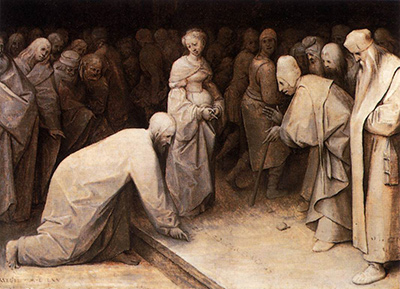Christ and the Woman Taken in Adultery is a small panel painted by Pieter Bruegel the Elder in 1565.
It depicts a well-known biblical episode, known as the Pericope Adulterae, from the Gospel of John 8:1-11. In this episode, an adulterous woman is brought before Jesus by a group of men for judgement.
Moses had commanded that adulterers be stoned, but Jesus refuses to condemn the woman. He instead writes upon the ground, though exactly what he wrote is unknown.
In this piece, however, Breugel shows him writing in Dutch what Jesus then tells the group: "Let anyone among you who is without sin be the first to throw a stone at her." The men leave and Jesus bids the woman "go, and sin no more."
This episode is the origin of the English idiom "to cast the first stone".
It has also been the subject of many other paintings, particularly from the Renaissance period on, including pieces by Rembrandt and Guercino.
There are even a number of copies of this work, including another painted by Bruegel's son, Pieter Bruegel the Younger, in 1600 and an engraving produced in 1579 by Paul Perret.
Bruegel has a reputation for vivid, lively paintings. Christ and the Woman Taken in Adultery is one of his only three surviving pieces painted in the grey monochrome style known as grisaille, the others being The Death of the Virgin and Three Soldiers.
After being sold by the family in the 17th century, this piece has changed hands many times. Notably, it was stolen in 1982 from the Courtauld Gallery. Proving impossible to sell due to its fame, it remained in the possession of the thieves until returned to the gallery by police in 1992.




